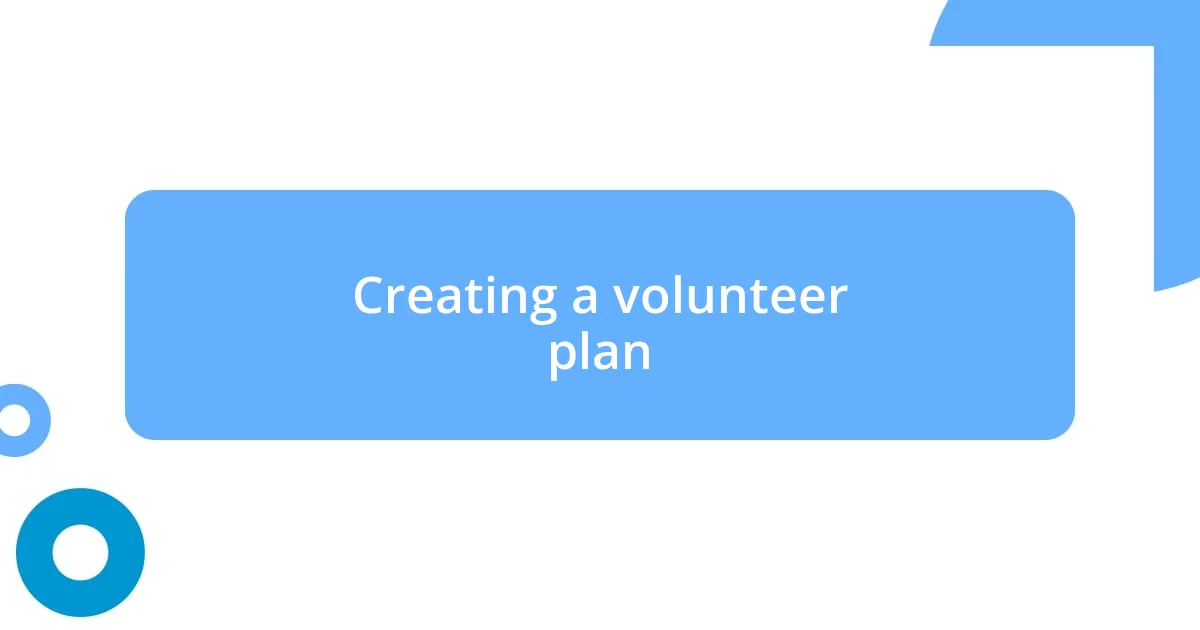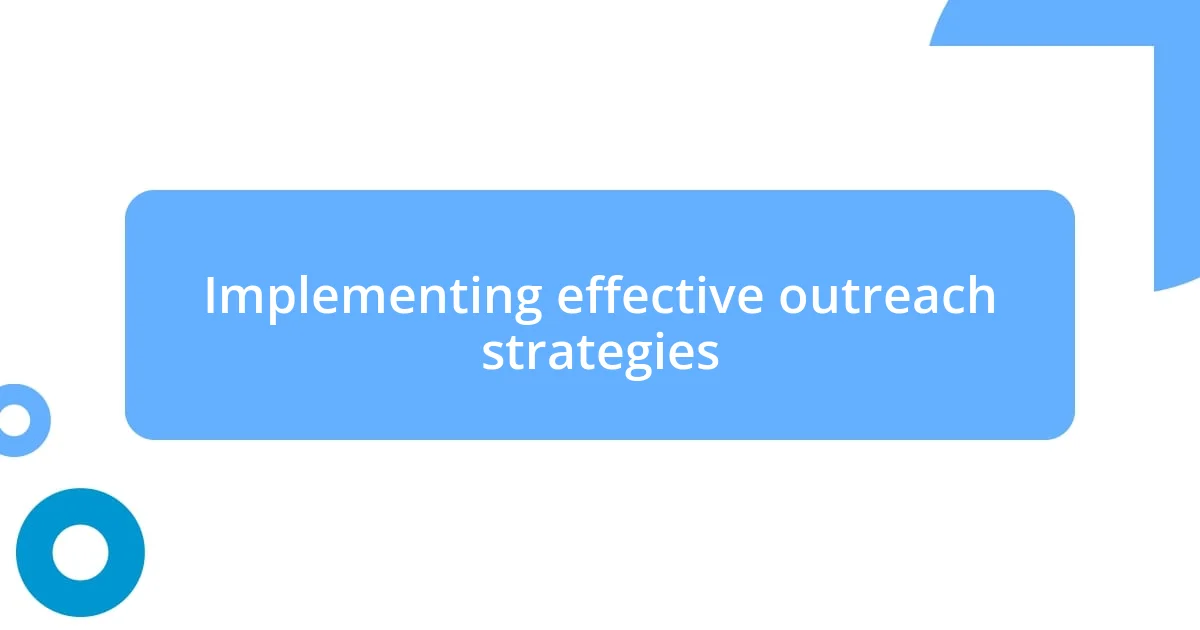Key takeaways:
- Understanding community needs requires active listening and recognizing the diverse backgrounds of members, which helps uncover hidden challenges.
- Creating a volunteer plan involves defining objectives, mapping out a timeline, and maintaining flexibility to adapt to unforeseen circumstances.
- Sustaining long-term engagement is achieved through consistent communication, fostering leadership opportunities, and collaboratively addressing challenges within the community.

Understanding community needs
Understanding the needs of a community can be like peeling an onion—layer by layer, there are often overwhelming emotions and hidden complexities beneath the surface. I remember my first community meeting; I was surprised to see a range of concerns, from access to education for children to the lack of safe spaces for teens. How often do we really stop to listen to what our neighbors are struggling with?
During my time volunteering, I realized that asking the right questions was just as important as the answers I received. I often found myself engaging in heartfelt conversations with locals, many of whom felt unheard. For instance, one elderly woman shared how isolation affected her mental health. In that moment, it struck me: how can we create a more supportive environment if we don’t take the time to understand these individual stories?
Another vital aspect of understanding community needs is recognizing the diverse backgrounds of its members. I recall attending a cultural fair where different groups showcased their heritage, and it was eye-opening to see how unique challenges stemmed from cultural differences. It made me ponder: how can we foster unity if we don’t acknowledge and celebrate our diverse perspectives? Embracing this diversity not only reveals the community’s true needs but also enriches the shared experience of volunteering.

Identifying volunteer opportunities
Finding the right volunteer opportunities starts with observing the pulse of your community. I remember walking through my neighborhood park one day, noticing how littered it was and how few people were enjoying the space. It hit me that while I had my own interests, engaging with environmental issues could create a more vibrant atmosphere for everyone. From casual chats with fellow park-goers, I learned about a local cleanup group, which opened the door to volunteering efforts I never knew existed.
To effectively identify volunteer opportunities, consider the following strategies:
- Explore local nonprofits: Research organizations that align with your interests—many of them list current needs right on their websites.
- Attend community events: These can offer insight into pressing local issues, connect you with passionate individuals, and display opportunities for involvement.
- Engage on social media: Sometimes, a quick scroll through community groups or Nextdoor can reveal heartfelt calls for help from neighbors.
- Reach out to friends: Talking to friends about their volunteering experiences can uncover options you might not have considered.
- Observe your surroundings: Look for gaps in services or support—there’s often a need hiding in plain sight.
By actively seeking these opportunities, I found a deeper connection to my community and gained a sense of purpose, realizing that volunteering isn’t just about giving—it’s about growing.

Creating a volunteer plan
Creating a volunteer plan begins with defining your objectives. Think about what you want to achieve through your volunteering efforts. For me, it was crucial to strike a balance between helping others and growing myself. I found it uplifting to list my skills and interests—this helped me identify where I could make the most impact while staying energized and motivated.
Once I established my goals, I mapped out a realistic timeline. This was a game-changer for keeping me focused and accountable. Reflecting back, I remember coordinating a monthly food drive that required not just my time but also networking with local grocery stores. Breaking this down into manageable steps—like securing donations and organizing volunteers—made it feel less overwhelming. How does your schedule alignment play a role in your volunteer activities? For me, it made all the difference.
Lastly, embracing flexibility within your plan is essential. During my volunteering journey, unexpected challenges often popped up—like when a storm canceled our community garden day. Instead of being frustrated, I adjusted my plan by organizing an online workshop on sustainable gardening practices instead. This adaptability not only kept morale high but also sparked new learning opportunities for everyone involved. It taught me that a solid plan is important, but being open to change can lead to beautiful new paths.
| Steps to Creating a Volunteer Plan | My Experience |
|---|---|
| Define Objectives | Identified my passions and aligned them with community needs. |
| Map Out a Timeline | Broke tasks into manageable parts, like organizing a monthly food drive. |
| Embrace Flexibility | Adjusted plans when faced with unexpected challenges, like rescheduling a workshop. |

Building a motivated team
Building a motivated team is all about understanding what drives individuals. I once gathered a group of enthusiastic volunteers for a tree-planting initiative and quickly realized that everyone had different reasons for being there. Some were passionate about clean air, while others wanted to beautify their neighborhood. Recognizing these motivations allowed us to come together with a common purpose, fueling our energy during the event.
Creating an environment of appreciation is also essential in nurturing motivation. During one of our community cleanup days, I made a point to celebrate even the smallest victories—like collecting an impressive amount of trash in just an hour. I encouraged everyone to share their thoughts and feelings about the impact we were making. That acknowledgment sparked joy across the group, reinforcing our commitment to the mission. When was the last time you noticed how close a simple “thank you” can bring a team together?
Additionally, fostering open communication can be a game-changer. In my experience, I found that establishing a group chat helped us stay connected beyond events. We shared updates, brainstormed new ideas, and even discussed personal victories. This created a sense of community where everyone felt valued and heard. Reflecting on it, I believe that when team members feel like they belong, they are far more likely to stay engaged and motivated in their volunteer roles. What have you done to keep your team informed and connected?

Implementing effective outreach strategies
Effective outreach strategies are pivotal in connecting with your community and ensuring your volunteer efforts have a lasting impact. I remember the first time I reached out to local businesses for our food drive—I felt a mix of excitement and nervousness. Crafting personalized messages instead of generic ones made all the difference. I asked if they could help, not just for us, but to make a real change together. That personal touch resonated with them, and many were eager to contribute.
When planning outreach, utilizing various channels amplifies your message. I discovered that social media often garners a wider audience, but don’t underestimate the power of a few well-placed posters in the neighborhood. I once put up flyers in local coffee shops and community centers, and the feedback was immediate. It made me wonder—how will people respond to an invitation if it’s placed where they routinely gather? This approach not only engaged locals but also sparked conversations about our initiative, expanding our reach organically.
Finally, follow-up is key to maintaining relationships built through outreach. After our food drive, I sent thank-you messages to everyone involved, sharing photos and the impact of their contributions. I vividly recall receiving replies filled with joy and eagerness to participate in the next event. It made me realize that nurturing these connections leads to a stronger, more engaged community. So, I ask you, how do you plan to keep those conversations going after the initial contact? The relationships we build can sustain our efforts long beyond a single event.

Measuring impact and success
Measuring the impact of community volunteering can often feel like a daunting task, but I’ve found that quantifying results is truly possible with a bit of creativity. For instance, after we organized a literacy program, we conducted surveys to gather feedback from participants and volunteers alike. The excitement was palpable when we discovered that 85% of attendees reported improved reading skills. Reflecting on those numbers, I realized those statistics aren’t just figures; they represent lives being changed and futures brightened.
In another instance, I initiated a volunteer day at our local park and tracked the amount of litter collected. To my surprise, we filled seven bags, which was way more than I anticipated! This tangible result was not just about cleaning up; it was a direct reflection of our community’s growing awareness about the importance of environmental stewardship. Community members began sharing their own experiences of cleanliness and biodiversity in the area, which made me wonder—what shifts do you think occur when people witness such collective efforts?
Ultimately, success is not solely about numbers; it’s about the stories we gather along the way. I still remember one child’s face lighting up when they were able to read their first book during our program. Moments like these reinforce my belief that measuring impact is equally about emotional transformations as it is about data. Have you tracked your success in any unusual ways that made a lasting impression on you or your community? Those narratives are often the ones that inspire others to join in and create even more change.

Sustaining long-term community engagement
Sustaining long-term community engagement requires consistent communication and shared experiences. I remember the thrill of organizing monthly potlucks after our successful events. It became a space where everyone felt they could share their stories and ideas freely. Those gatherings weren’t just about food; they deepened our connections and aligned our visions for future projects. Have you considered how casual interactions can strengthen relationships? They can truly transform the way you collaborate on community initiatives.
Another strategy that I found effective is creating opportunities for leadership within the community. When I started a mentorship program, I encouraged participants to take charge of small projects. Watching them grow from volunteers to leaders was incredibly rewarding. One young woman, previously shy and reserved, stepped up to lead a workshop for kids. The pride in her eyes was contagious. How empowering it is to see others flourish! By enabling individuals to take ownership, I realized we not only sustain engagement but also foster a sense of pride and investment in our collective efforts.
Lastly, addressing challenges together is vital for ongoing commitment. It’s easy for enthusiasm to wane when obstacles arise. I faced this when my community garden initiative hit a snag due to funding issues. Instead of allowing frustration to take over, we gathered to brainstorm solutions. This collaborative approach turned adversity into an opportunity for innovation. I often ask myself, how do we turn setbacks into stepping stones? It’s vital to involve everyone in the process; this fosters resilience and ensures that our shared mission remains strong, no matter the hurdles we encounter.














